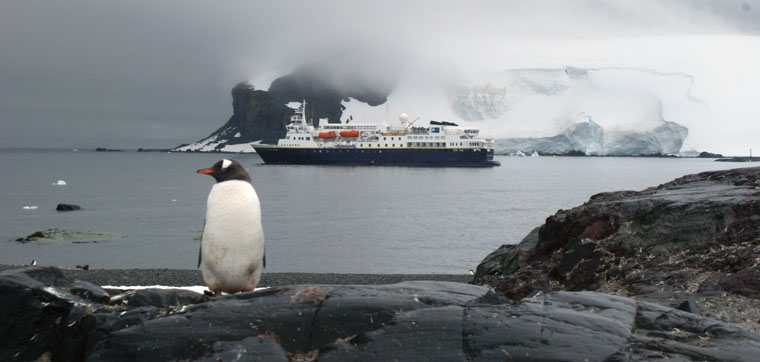|
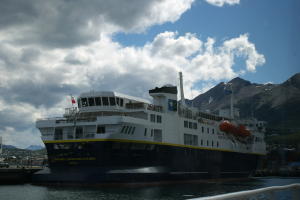 In
January, 2009, we joined Linblad Expeditions for a cruise to Antarctica,
South Georgia and the Falkland Islands. Our home for 21 days was
the National Geographic Explorer. This ship was newly refurbished
and very beautiful as well as comfortable. In
January, 2009, we joined Linblad Expeditions for a cruise to Antarctica,
South Georgia and the Falkland Islands. Our home for 21 days was
the National Geographic Explorer. This ship was newly refurbished
and very beautiful as well as comfortable.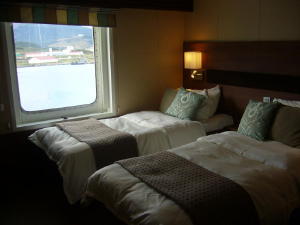 Our
cabin had two twin beds, a desk, chair, flat screen tv, and internet
capability. The bathroom was spacious with a walk in shower. There
were plenty of drawers and shelves for all that we brought. Because
the ship was outfitted with stabilizers, she rode the high seas
very well so we were never seasick. There were 121 passengers on
board. All meals were open seating so we got to meet most of them.
For more photos of the Explorer, go to the Photo
Gallery - Ship. Our
cabin had two twin beds, a desk, chair, flat screen tv, and internet
capability. The bathroom was spacious with a walk in shower. There
were plenty of drawers and shelves for all that we brought. Because
the ship was outfitted with stabilizers, she rode the high seas
very well so we were never seasick. There were 121 passengers on
board. All meals were open seating so we got to meet most of them.
For more photos of the Explorer, go to the Photo
Gallery - Ship.
We began the trip by flying from Miami to Santiago, Chile, an 8
hour flight. After a brief bus tour of the city and an overnight
at the Grand Hyatt Hotel, we flew 3 hours to Ushuaia, Argentina.
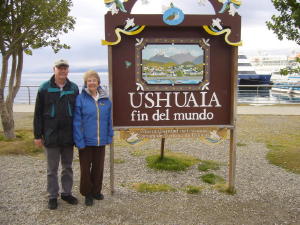 This
is the southernmost city in the world and the jumping off point
for most cruises to Antarctica. Before boarding our ship, we were
given lunch and a sail through the Beagle Channel on a catamaran.
Then it was off on our great adventure. The first two days were
spent at sea, crossing the Drake Passage. We had heard horror stories
of severe seas on this body of water but were very fortunate to
have only light swells. Then it was time for our first landing. This
is the southernmost city in the world and the jumping off point
for most cruises to Antarctica. Before boarding our ship, we were
given lunch and a sail through the Beagle Channel on a catamaran.
Then it was off on our great adventure. The first two days were
spent at sea, crossing the Drake Passage. We had heard horror stories
of severe seas on this body of water but were very fortunate to
have only light swells. Then it was time for our first landing.
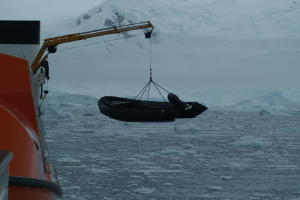
January is summer in Antarctica but the weather is more like the
month of March in Colorado. Temperatures were usually in the mid
30's but on a clear, sunny day it felt like 50. Weather changed
almost by the hour and we came to expect rain, snow, sun and wind
all in the same day.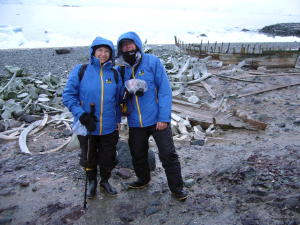 Because
landings from the zodiaks were usually on a beach, we wore knee-high
rubber boots to wade thru the water. These were also needed for
the hikes which were often thru snow and/or mud. And waterproof
pants (we brought our ski pants) were essential. Linblad supplied
everyone with parkas and they worked wonderfully to keep us warm
and dry. Because
landings from the zodiaks were usually on a beach, we wore knee-high
rubber boots to wade thru the water. These were also needed for
the hikes which were often thru snow and/or mud. And waterproof
pants (we brought our ski pants) were essential. Linblad supplied
everyone with parkas and they worked wonderfully to keep us warm
and dry.
No single country owns the Antarctic Continent. 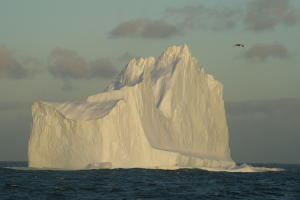 Through
a treaty signed in 1959, countries have agreed to abide by certain
rules when visiting or setting up research stations there. In order
to preserve the unique natural environment, only 100 people are
allowed to land at any one time. We were divided into 4 groups with
all groups going ashore but in rotation. Before and after going
ashore, we dunked our boots in an antiseptic solution and scrubbed
off the mud. Our ship had a "mud room" with lockers where
we stored our boots after each excursion. Through
a treaty signed in 1959, countries have agreed to abide by certain
rules when visiting or setting up research stations there. In order
to preserve the unique natural environment, only 100 people are
allowed to land at any one time. We were divided into 4 groups with
all groups going ashore but in rotation. Before and after going
ashore, we dunked our boots in an antiseptic solution and scrubbed
off the mud. Our ship had a "mud room" with lockers where
we stored our boots after each excursion.
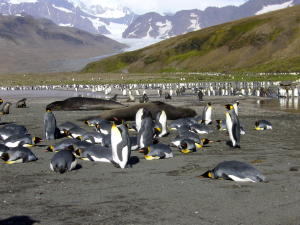 Almost
everyone on board had a digital camera - some point and shoot but
most SLR's with telephoto lenses. This was a photo expedition and
there was a National Geographic photographer onboard as well as
an underwater photographer and staff video chronicler. And Antarctica
is a photographer's dream. Like the Galapagos, we were able to get
up close and personal with the animals who seemed not to care that
we were in their home.We saw 5 kinds of penguins, 4 kinds of seals,
15 species of birds, reindeer, whales and dolphins. Almost
everyone on board had a digital camera - some point and shoot but
most SLR's with telephoto lenses. This was a photo expedition and
there was a National Geographic photographer onboard as well as
an underwater photographer and staff video chronicler. And Antarctica
is a photographer's dream. Like the Galapagos, we were able to get
up close and personal with the animals who seemed not to care that
we were in their home.We saw 5 kinds of penguins, 4 kinds of seals,
15 species of birds, reindeer, whales and dolphins.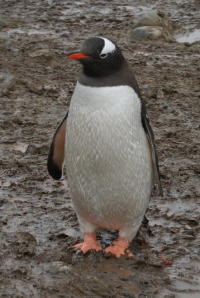 There were 10 naturalists on board who kept us educated on all the
wildlife, geology and history of the region. In addition, we had
2 researchers from Oceanites who's job it was to count the penguins
at each landing site in Antarctica. This data is used to determine
how the population is changing.
There were 10 naturalists on board who kept us educated on all the
wildlife, geology and history of the region. In addition, we had
2 researchers from Oceanites who's job it was to count the penguins
at each landing site in Antarctica. This data is used to determine
how the population is changing.
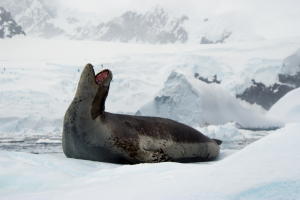 Our
cruise took us to landings on Antarctica as well as South Georgia
and the Falkland Islands. A map with our route and landings can
be viewed by going to Antarctica Maps. Our
cruise took us to landings on Antarctica as well as South Georgia
and the Falkland Islands. A map with our route and landings can
be viewed by going to Antarctica Maps.
To read about each place we visited and see a few photos from that
area, go to Antarctica Newsletters.
You can view more photos from our trip by going to the Photo
Gallery. And if you want to see a full size picture, just click
on the photo. 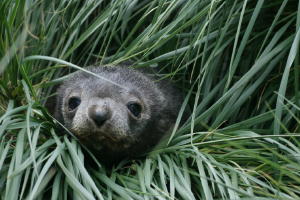
Home
Locations Visited Photos
Map Contact
Us
|
